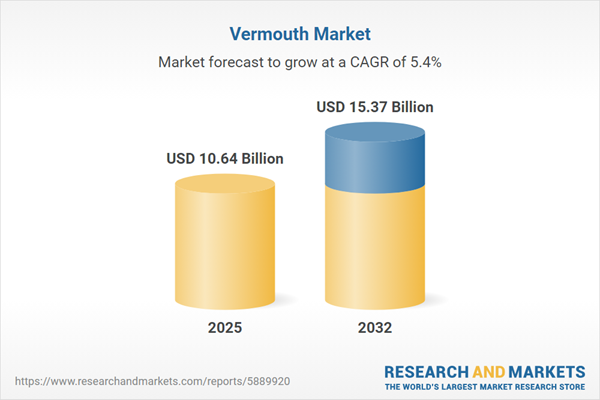Speak directly to the analyst to clarify any post sales queries you may have.
Senior leaders in the Vermouth Market are adapting to heightened consumer interest, an expanding array of product choices, and new sales pathways. To stay competitive, category frontrunners emphasize innovation, resilience, and forward-thinking strategies in both mature and emerging segments.
Market Snapshot: Size, Growth, and Outlook for the Vermouth Market
The Vermouth Market grew from USD 10.08 billion in 2024 to USD 10.64 billion in 2025, with projected sales reaching USD 15.37 billion by 2032. This reflects a compound annual growth rate (CAGR) of 5.41%.
Growth is propelled by changing consumption patterns and strong demand for premium fortified wines across international markets. Momentum stems from frequent product launches, interest in elevated taste experiences, and the rise of new consumption occasions. Both retail and hospitality channels are driving market expansion, while digital commerce and omni-channel strategies widen reach and sharpen global competitiveness.
Scope & Segmentation of the Vermouth Market
- Product Types: Bianco, Dry, Rosso, Rosé, and Sweet product options capture a range of preferences, meeting the needs of the mixology sector and broad retail audiences.
- Distribution Channels: Duty Free, E-Commerce, Convenience Stores, Specialty Liquor Stores, Supermarkets and Hypermarkets, Bars and Pubs, Hotels and Resorts, and Restaurants are key touchpoints reinforcing brand accessibility and enabling cross-channel sales opportunities.
- Packaging Types: Offerings include 1 L Bottle, 375 ml Bottle, and 750 ml Bottle formats, serving businesses, hospitality venues, and individual consumers for a diverse mix of end-users and environments.
- Alcohol Content: High ABV (above 18 percent), Low ABV (below 16 percent), and Standard ABV (16–18 percent) categories adjust to evolving consumer preferences for beverage strength and flavor complexity.
- End Use: Cocktail Ingredient, Ready-To-Drink, and Straight Consumption support varied applications from professional bars to direct consumption, reflecting increased interest in convenience and versatility.
- Form: Conventional Vermouth and Ready-To-Drink Mixtures offer flexible formats targeting both established traditions and emerging convenience trends.
- Regions Covered: Americas (including the United States, Canada, Mexico, Brazil, Argentina, and others), Europe, Middle East and Africa (with a focus on the United Kingdom, Germany, France, Italy, selected African and Gulf States), and Asia-Pacific (encompassing China, India, Japan, Australia, South Korea, and Southeast Asia) frame critical regional opportunities and illustrate distinct supply-demand balances.
- Companies Analyzed: Bacardi Limited, Davide Campari-Milano S.p.A., Pernod Ricard S.A., Gruppo Montenegro S.p.A., Distillerie Dolin S.A.S., Giulio Cocchi S.p.A., Gancia S.p.A., Stock Spirits Group plc, Lucas Bols N.V., and Koninklijke De Kuyper Royal Distillers B.V. serve as industry benchmarks for innovation, operational adaptation, and market leadership.
Key Takeaways for Senior Decision-Makers
- Premiumization is a prominent driver, encouraging authenticity in production and enhancing brand differentiation within a competitive market.
- Adoption of sustainable sourcing and packaging practices is increasingly important to reputation management and helps foster partnerships based on shared values.
- Direct-to-consumer and omni-channel models are redefining customer engagement, supporting extended reach outside traditional retail structures.
- Market expansion into low- and non-alcoholic variants mirrors consumer wellness priorities and opens pathways to new customer segments seeking complex alternatives with lighter profiles.
- Advanced segmentation by flavor, container size, and usage format sustains relevance among both professional mixologists and convenience-driven consumers.
- Local market adaptation, including collaboration and region-specific products, enables organizations to anticipate shifts in regional preferences and maintain agility amid evolving dynamics.
Tariff Impact: Implications of U.S. Trade Policy on Vermouth
Recent U.S. tariffs on imported fortified wines have shifted cost structures, prompting European producers to evaluate distribution choices and sourcing strategies. The current environment is driving businesses to revise procurement models, explore domestic partnerships, and consider new packaging approaches. In response, suppliers targeting U.S. retail and hospitality must reassess end-to-end supply chains and adapt their operational frameworks to maintain competitiveness.
Methodology & Data Sources
This analysis utilizes a rigorous blend of audited industry literature, company documents, regulatory reports, and interviews with sector stakeholders. Segmentation analytics and scenario modeling techniques provide a validated foundation for senior executive decisions.
Why This Report Matters for Strategic Growth
- Delivers detailed segmentation and actionable insights on product categories and regional trends, supporting robust investment strategies.
- Supplies intelligence on evolving distribution models and market dynamics, providing guidance for both immediate and long-term alignment.
- Benchmarks competition, regulation, and supply chain practices for effective risk assessment and market positioning in a dynamic environment.
Conclusion
The Vermouth Market is navigating significant shifts shaped by regulation, evolving consumer priorities, and sustained product innovation. This report equips organizations with frameworks to respond effectively to market change and achieve targeted growth.
Additional Product Information:
- Purchase of this report includes 1 year online access with quarterly updates.
- This report can be updated on request. Please contact our Customer Experience team using the Ask a Question widget on our website.
Table of Contents
3. Executive Summary
4. Market Overview
7. Cumulative Impact of Artificial Intelligence 2025
List of Figures
Samples

LOADING...
Companies Mentioned
The key companies profiled in this Vermouth market report include:- Bacardi Limited
- Davide Campari-Milano S.p.A.
- Pernod Ricard S.A.
- Gruppo Montenegro S.p.A.
- Distillerie Dolin S.A.S.
- Giulio Cocchi S.p.A.
- Gancia S.p.A.
- Stock Spirits Group plc
- Lucas Bols N.V.
- Koninklijke De Kuyper Royal Distillers B.V.
Table Information
| Report Attribute | Details |
|---|---|
| No. of Pages | 188 |
| Published | October 2025 |
| Forecast Period | 2025 - 2032 |
| Estimated Market Value ( USD | $ 10.64 Billion |
| Forecasted Market Value ( USD | $ 15.37 Billion |
| Compound Annual Growth Rate | 5.4% |
| Regions Covered | Global |
| No. of Companies Mentioned | 11 |









